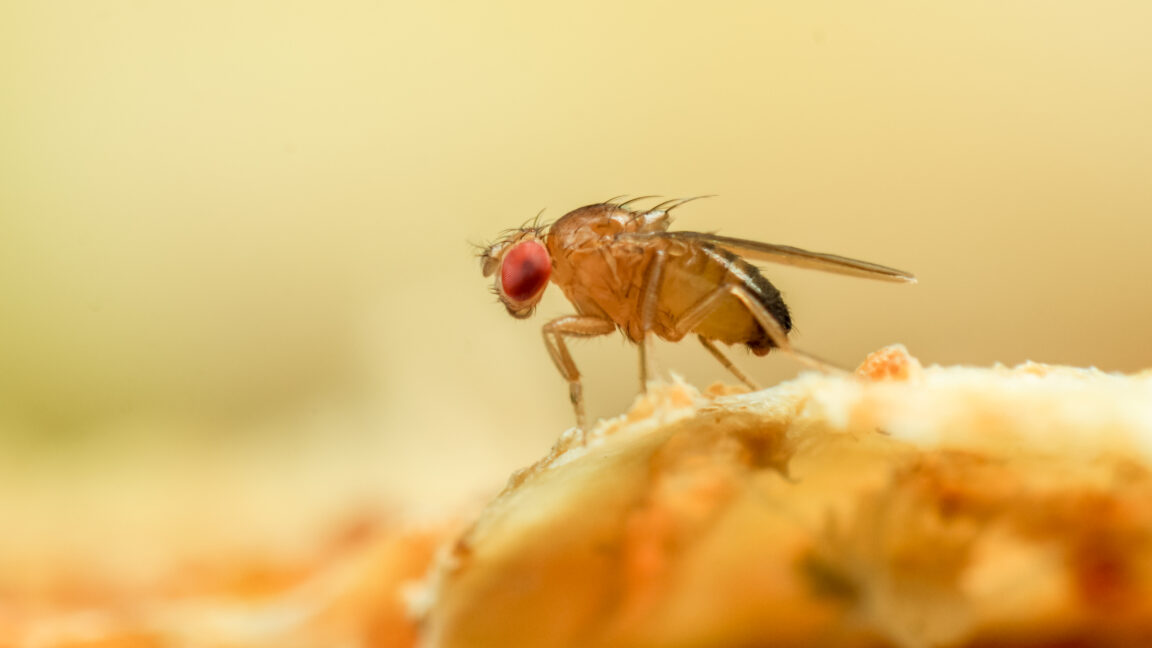There are negative consequences for the flies, but they avoid being eaten alive.
Have you ever pulled an all-nighter because of anxiety? Found yourself doomscrolling on your phone when you should have gone to bed hours ago? Purposely downed too many cups of coffee at three in the morning? There are some insomniac flies who would like a word.
It appears that fruit flies that spend their days lazily buzzing through the lush orchards and rainforests of Queensland, Australia, live in paradise. That changes at sunset. After dark, the flies are plagued by the Gamasodesqueenslandicus mites, which can attach themselves like ticks and literally eat the flies alive in their sleep. Researchers led by University of Cincinnati biologist Joshua Benoit have now discovered that flies that have had enough of the mites will stay awake at the expense of their health.
These mite-resistant flies drain their nutrient reserves to stay up all night, making them more susceptible to starvation. Insomniacs consumed more oxygen and were generally more active than non-resistant flies; they also experienced changes in gene activity related to their metabolisms.
Having a breakdown
Fruit flies (Drosophila melanogaster) may be pests to humans, but they have their own pests to contend with. Ectoparasitic mites such as G. queenslandicus are some of the worst. Being bitten can put the flies' immune and repair responses into overdrive, at great energy cost. Parasitized flies are also less successful at mating.
Given all that, the flies are likely better off staying awake and in defense mode.
Benoit and his team compared the flies’ daytime and nighttime activities. They also bred generation after generation of mite-resistant flies to see how their resistance would evolve. When humans purposely select for or against certain features in other organisms like this, it's known as artificial selection. This was meant to give the researchers an idea of how mite-resistant flies evolve in response to mites in nature.
While many genes saw changes after the researchers selected for mite resistance, those associated with metabolic processes such as glycolysis, which involves enzymes breaking down glucose, were especially affected.
“We found that more than 30 metabolism genes were differently [activated] in these flies, suggesting they were burning their energy a little faster than you’d expect,” Benoit said in a press release.
Those genes associated with metabolism were upregulated, meaning they showed an increase in activity. An observed loss of body fat and protein reserves was evidently a trade-off for resistance to mites. This suggests there was increased lipolysis, or the breakdown of fats, and proteolysis, the breakdown of proteins, in resistant lines of flies.
Parasite paranoia
The depletion of nutrients could make fruit flies less likely to survive even without mites feeding off them, but their tenaciousness when it comes to staying up through the night suggests that being parasitized by mites is still the greater risk. Because mite-resistant flies did not sleep, their oxygen consumption and activity also increased during the night to levels no different from those of control group flies during the day.
Keeping mites away involves moving around so the fly can buzz off if mites crawl too close. Knowing this, Benoit wanted to see what would happen if the resistant flies’ movement was restricted. It was doom. When the flies were restrained, the mite-resistant flies were as susceptible to mites as the controls. Activity alone was important for resisting mites.
Since mites are ectoparasites, or external parasites (as opposed to internal parasites like tapeworms), potential hosts like flies can benefit from hypervigilance. Sleep is typically beneficial to a host invaded by an internal parasite because it increases the immune response. Unfortunately for the flies, sleeping would only make them an easy meal for mites. Keeping both stereoscopic eyes out for an external parasite means there is no time left for sleep.
“The pattern of reduced sleep likely allows the flies to be more responsive during encounters with mites during the night,” the researchers said in their study, which was recently published in Biological Timing and Sleep. “There could be differences in sleep occurring during the day, but these differences may be less important as D. melanogaster sleeps much less during the day.”
Fruit flies aren’t the only creatures with sleep patterns that parasites disrupt. Evidence of shifts in sleep and rest in birds and bats has been shown to happen when there is a risk of parasitism after dark. For the flies, exhaustion has the upside of better fertility if they manage to avoid bites, so a mate must be worth all those sleepless nights.
Biological Timing and Sleep, 2025. DOI: 10.1038/s44323-025-00031-7
Hope you enjoyed this news post.
Thank you for appreciating my time and effort posting news every day for many years.
News posts... 2023: 5,800+ | 2024: 5,700+ | 2025 (till end of April): 1,811
RIP Matrix | Farewell my friend ![]()



3175x175(CURRENT).thumb.jpg.b05acc060982b36f5891ba728e6d953c.jpg)
Recommended Comments
There are no comments to display.
Join the conversation
You can post now and register later. If you have an account, sign in now to post with your account.
Note: Your post will require moderator approval before it will be visible.